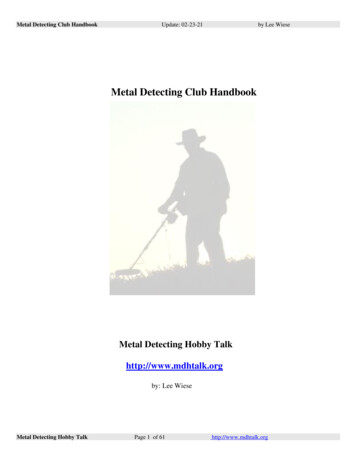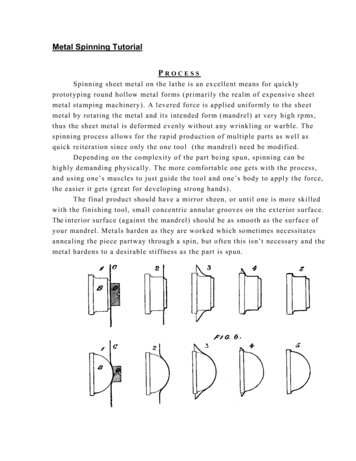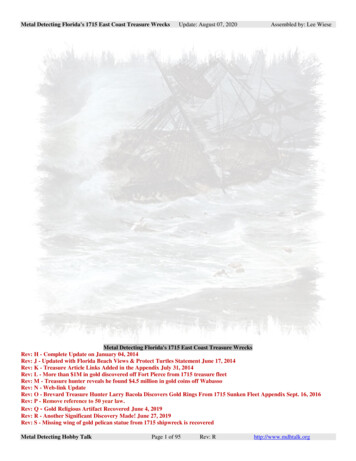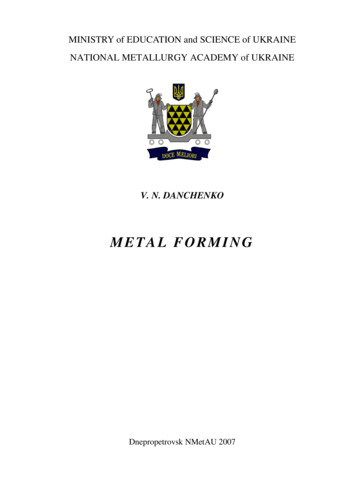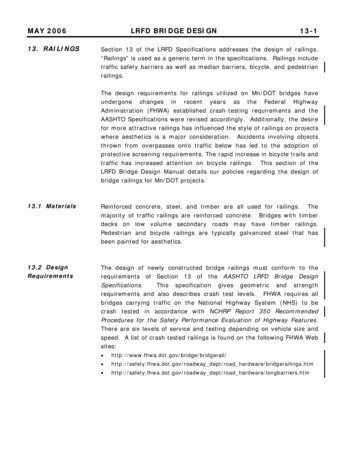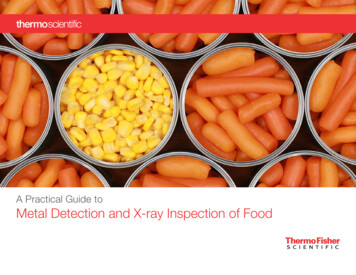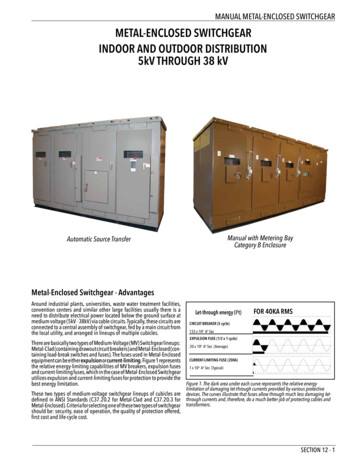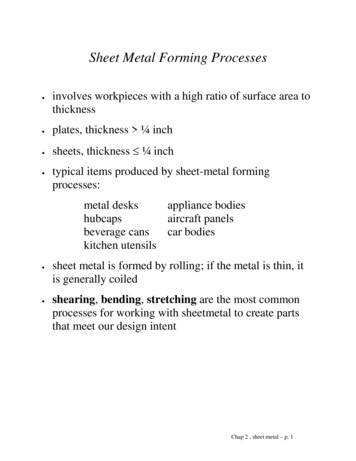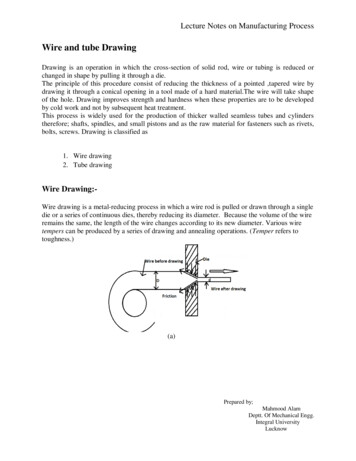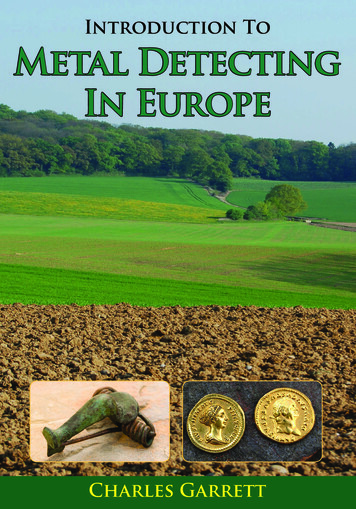
Transcription
Introduction ToMetal DetectingIn EuropeCharles Garrett
Introduction ToEuropeanMetalDetectingCharles Garrett
Front cover photos:Freshly plowed farmland in Belgium where Romanand French artifacts were recovered by Garrett metaldetectorists. Inset pictures are of an ancient Romanfibula brooch found in England and two rare hammered gold coins.Rear cover photo:A Spanish detectorist at a rally seen using an ACE250 metal detector.
Introduction ToEuropeanMetalDetecting
Introduction to EUROPEAN METAL DETECTING Charles L. Garrett 2009Manufactured in the United States of America.All rights reserved.No part of this book may be reproduced ortransmitted in any form or by any means, electronicor mechanical, including photocopying, recordingor by any information storage or retrieval system,except in the case of brief quotations embodied incritical articles and reviews. For information, addressall inquiries to Editor, Ram Publishing Company.First printing: September 20094www.garrett.com
CONTENTSAbout the Author.7Introduction.9A Vast Searchground.11Coins and Caches.12Buckles, Brooches and Jewelry.19Relics and Tools.24Prospecting and Coastal Hunting.27Discrimination and Target ID.29European Hunting Tips.35Research Pays Off.35Learn the Laws.36Use Headphones and a Pinpointer.38Join a Club and Attend Rallies.42Involve Your Family.45Some Personal Experiences.47Cleaning Your Treasures.55European Code of Ethics.58Special Advice.63Other RAM Books.69Introduction to European Metal Detecting5
Author Charles Garrett, seen on one of his expeditions searchinga fort where French and British forces once clashed.6www.garrett.com
ABOUT THE AUTHORFor more than 45 years, Charles Garretthas pioneered the development of the modernmetal detector, demonstrated its capabilitiesin searches worldwide and devoted himself toteaching others to use detectors. He has recovered treasures of all types and has made a number of trips to the European treasure fields.The author’s lifetime interest in treasurehunting prepared him to excel in that field.After earning a Bachelor of Science Degreein Electrical Engineering, Charles Garrettworked at two Dallas, Texas, companies, TexasInstruments and Teledyne Geotech, where hedeveloped systems and equipment required byAmerica’s fledgling space effort. While devoting himself to his hobby, he designed and builthis own metal detectors. This avocation becamea career when he and his wife, Eleanor, foundedGarrett Electronics in 1964 to manufacture andmarket his inventions.Garrett quality is praised today throughoutthe world. From the beginning, Garrett vowedIntroduction to European Metal Detecting7
“to practice what I preach” by field-testingevery piece of his equipment—to insure thateach detector works for customers regardlessof ground conditions and environment. He hasbecome recognized as an unofficial spokesmanfor the hobby of treasure hunting and the metaldetecting industry through a long list of honors,personal appearances and books.This book on hunting for treasure in Europemarks the latest installment in Charles Garrett’spocket-sized treasure hunting field guides. He isdevoted to disseminating such knowledge in aformat that is both convenient and effective forhelping individuals recover more treasure withtheir metal detectors.8www.garrett.com
INTRODUCTIONAs implied by its title, this sixth edition ofmy pocket-sized treasure-hunting field guideseries is intended to acquaint hobbyists withthe exciting possibilities offered by metaldetecting in Europe. The coins and relics foundvirtually anywhere in Europe can literally dateback hundreds or even thousands of yearsearlier than those items we are thrilled torecover in North America.Due to the abbreviated nature of these small“how-to” reference books, we touch only briefly on the many great hunting opportunities thatEurope affords today’s metal detectorists. AsI write this introduction, however, the RAMBooks team is in the final stages of editing afull-length European Metal Detecting Journal.The subjects we touch upon in this field guidewill be covered in much greater detail in thelarger volume which will be filled with hundreds of full-color photos of beautiful coins,caches, jewelry, artifacts, military relics andIntroduction to European Metal Detecting9
assorted treasures found by me and many European metal detectorists.During my years of testing metal detectors,I have had the pleasure of recovering treasuresin England, Scotland, France, Spain, Germanyand Italy. Finding my first Roman coin is an experience I shall never forget.For our North American readers, don’t thinkthat metal detecting in Europe is out of yourreach. Some detecting clubs organize annualtrips overseas to hunt in prime areas of Europe.You can also contact European treasure huntinggroups directly to express your interest in joining them in their searches.I hope to see you in the field 10www.garrett.comGarland, Texas
A VAST SEARCHGROUNDEuropean metal detectorists are uniquelyable to go into the field and find some of theoldest metallic artifacts on Earth in places allacross the continent. Some date back to theBronze Age—more than 4,000 years ago—withmore “recent” Roman, Celtic or Viking treasures older than 2,000 or more years.The first evidence of man’s existence inEurope dates back to around 35,000 BC, duringthe European Paleolithic period. The preferredmetal for tools and weapons of the more civilized Neolithic period was bronze and historians have labeled this the Bronze Age.The treasures being recovered in Europetoday are often as much fun to identify as theyare to find. Coins minted in the past few hundred years generally have dates pressed intotheir designs. Other coins that you recover,however, might require special reference booksor professional assistance to identify. The samecan be said for certain pieces of jewelry, fasteners, tools, keys and other artifacts.Introduction to European Metal Detecting11
Bronze, copper and gold were all used tofashion items from the Bronze Age. Some castbronze axes have been recovered in Europe thatdate back prior to 2000 BC. Iron Age (700–50BC) artifacts created with wrought iron havelargely rusted away although some nice recoveries have been made in soils that helpedpreserve such items. Artifacts found that comefrom the last centuries of the Iron Age are generally of more Germanic or Celtic influence.Celtic craftsmen created elegant coins that arefound today in parts of Europe that includesFrance, Belgium, the Netherlands, Great Britain, Germany, Austria and Spain.The Roman Empire spread through muchof Europe from about 50 BC through the latterpart of the 4th century. Roman coins and artifacts can therefore be found in the same fieldswhere modern medieval relics from the European Middle Ages are unearthed. Coins and CachesDuring the height of the Roman Republic,territorial control expanded from Italy over the12www.garrett.com
Mediterranean area into western Europe andthe British Isles. Roman-era coins can thus befound from Italy all the way north and west tothe Netherlands. The same field is thus just aslikely to yield a fine Roman stater as a moderneuro coin.Many great coin hoards were buried duringtimes of conflict. In some cases, that personmay have been killed or driven out by conquerors, thus leaving such caches for today’s hunters. In some cultures, farmers threw coins in thefield for good luck or to celebrate a good cropseason. Other coins were lost by workers picking the crops or were even discarded in rubbishdumps when a new ruler came into power andmade the previous coins worthless.These three hammered gold coins—struck between 323 BC and69 AD—were found with a Garrett metal detector in Belgium.Introduction to European Metal Detecting13
Charles Garrett and his son Vaughan Garrett, seen in the GarrettMuseum, display some of the Roman and Greek coins they foundtogether on a prior European metal detecting trip.14www.garrett.com
I found a coin cache in a plowed field induring one of my European trips. I was scanning near an old embankment when I dug thefirst coin. In an area of about an arm’s width,I had soon unearthed another 20 ancient coins.The coins are from the 400 BC period andI figure they had once been in some sort ofbag when they were buried. My friend FrankMellish and several other detectorists with usalso found coins and various cast religious objects in this same field. Some of these coinsfrom the cache are on display in the GarrettMuseum in Garland, Texas.My son Vaughan accompanied me on atwo-week detecting expedition through Spain,France, Italy, Germany, England and Scotland.Among other places, we visited the stone andturf fortification in northern England known asHadrian’s wall. Roman Emperor Hadrian ordered the construction of these walls in 122 ADto ward off attacks on Roman Britain by a Scottish tribe and to mark the frontier of his empire.Known also as the Roman Wall, Hadrian’s wallran more than 70 miles in length.Introduction to European Metal Detecting15
Modern view of Hadrian’s Wall in northern England. The authorand his son Vaughan Garrett found Roman coins near this area.Much of this wall has disappeared in the past2,000 years but its remnants are now a populartourist site. Constructed of squared stone, thisancient wall in places was three meters wide(nearly ten feet) and five to six meters (16 to 20feet) high. Searching along this ancient frontier16www.garrett.com
border was certainly a highlight of my European hunting experiences.Later that day we searched a location thathad been a church centuries ago. The currentland owner built his home atop the ruins of theold site. Vaughan searched in the center of theyard near the back of the home. He got a strongsignal and recovered a mint condition Romancoin six inches deep. Shortly after, just a couplefeet away, Vaughan found another coin of thesame design, yet cut in half. These eleventhcentury coins were likely dropped by a churchmember nearly a thousand years ago! Thesecoins remain as my son’s favorite treasure find.Ancient caches, or hoards, were many timescontained in pottery or iron or brass pots beforebeing deeply buried. Through centuries of moremodern farm work, plows occasionally shatterthese containers and scatter the contents. Metaldetectorists continue to make great discoveriesof such hoards of coins year after year in Europe. Some of the most deeply buried cachesare best picked up with a detector equippedwith a two-box searchcoil, or Depth Multiplier.Introduction to European Metal Detecting17
This impressive hoard ofhundreds of Celtic coinswas found in an iron potby a European detectorist with a Garrett GTI2500.Some veteran European detectorists arecalled upon by families to help locate the stashes believed hidden by recently departed familymembers. These hobbyists generally charge thefamily a finder’s fee between 10% and 50% ofthe total treasure recovered.Thanks to the growth of the EuropeanUnion (EU) there are also a large number of18www.garrett.com
more modern collectible coins that detectoristscan find. At present the 27 countries who havejoined this alliance have discarded their formercurrency in favor of the euro. The smaller 1, 2and 5 euro cent coins, made of coppered steel,are the most erratic for your detector’s targetID scale. They can read so low on a Target IDscale that some detectorist who discriminateout iron might only faintly detect these lowdenomination coins. In dry sand and regularsoil conditions, you can employ more discrimination and still easily detect euros of 10-centand higher values. The bi-colour 1- and 2-eurocoins, which are larger and made of a nickel/brass/copper alloy, register as more solid hitswhen they are lying flat in the ground. Buckles, Brooches and JewelryEuropean hobbyists are able to find someof the oldest and most fabulous treasures onearth. Metal buttons used for practical clothing fasteners and for decoration can date backto 2000 BC. A popular find among detectoristsis a bronze fibula brooch, fasteners used byIntroduction to European Metal Detecting19
The gold and sapphire Middleham Jewel, found with a Garrettdetector in England, was first sold at auction for 1.3 million. TheYorkshire Museum later raised 2.5 million to buy back the exquisite Gothic pendant and return it to the UK.20www.garrett.com
The more cherished bronze fibula brooches (used to securecloaks and other clothing) are those recovered with intact clasps.Romans, Celts and other early civilizations forsecuring cloaks and other garments. Some fibulas can be quite ornate, including even animalfigurines in their design. Although most werecommonly constructed of bronze or pewter,some fibulas have been excavated that weremade of silver and even gold. Military andcivilian buttons, buckles and other fastenersare also quite popular to collect. Their shapes,design patterns and metal content vary both bygeography and eras of European history, eachIntroduction to European Metal Detecting21
Dutch detectorist Leo Kooistra pours out a bucket of thousandsof silver rings and necklaces he has found in the Netherlands andin Germany.22www.garrett.com
These gold, silver and bronze rings were found during 25 years ofsearching in Europe. Some of the older Roman and Celtic rings inthis case date back more than 2,000 years.piece like a snapshot of daily attire from thatperiod.Decorative Celtic pieces made from wroughtiron and bronze, with elegant Greek-influencedesigns, date back to the late centuries of theIron Age. Such pieces of Celtic influence arefound mainly in France, Spain, Belgium, England and Ireland. Early Celtic fasteners havebeen found in rectangular, square, triangularand even butterfly-shaped forms.Introduction to European Metal Detecting23
Equally coveted are early rings, jewelry,bronze figurines and medallions. Finger ringsbecame fashionable in the middle ages but havebeen around for thousands of years. They weresigns of a person’s wealth but were are alsoworn for a wide variety of purposes—mourning, religious, political, ceremonial and evenmedicinal. Some were set with precious stonesand inscribed with slogans of love, faith orstrength. There is obviously a special historyto finding a gold or silver finger ring that datesback to the Roman Republic era or even earlier. Relics and ToolsConflicts have been fought on European soilfor thousands of years including, more recently,World War I and World War II battles that occurred over much of this continent. Bayonets,ammunition belts, musket balls, metal uniformpieces and military paraphernalia of all description are found routinely by detectorists in manyEU countries.Most battlefields are considered historicsites. Some hunting clubs, however, partner24www.garrett.com
These are a few of the nearly 2,000 pounds of German and American military items found by the author and a Garrett search teamat a point near Koblenz, Germany. These relics are currently ondisplay in the Garrett Museum in Garland, Texas.This 9 cm.-long crossbow fibula was worn by a Roman centurion,a high-ranking officer in charge of at least 100 soldiers.Introduction to European Metal Detecting25
(Above) These recovered bronzeartifacts are (left to right) an 8cm. ax, a 15 cm tool, a 15 cmCeltic ax head from about 1500BC and a crop cutting tool believed to have originated fromthe Celts.(Right) This ancient Romansporting medallion, dating toabout 100 BC, was found by aFrench detectorist.26www.garrett.com
with professional archaeologists to serve as theskilled searchers who pinpoint artifacts. Forsome the thrill of seeing such history unearthedis just as rewarding as finding an object that canbe collected and displayed. You can preserveyour memories of such finds with photographsand you will know that these artifacts will helpeducate others when they are put on display.Be certain you aware of the laws in yourarea, particularly sites that have been deemedas archaeological areas before searching formilitary artifacts. Many other relics of earlycivilization can be discovered such as tools,pots, thimbles, locks, keys, silverware, decorative tobacco tins, hair pins, figurines, tokensand more. Prospecting and Coastal HuntingIt may be surprising to some to learn thatgold dust can be found in virtually all Europeancountries with the exception of the flat areas ofthe Netherlands and Denmark. Gold mining isactive in France and Spain while serious individual prospectors using metal detectors haveIntroduction to European Metal Detecting27
British detectorist John Howland found this Bulgari 18-carat ringset with 24 diamonds at the coast with his Garrett Sea Hunter.taken nuggets up to 35 ounces in recent yearsfrom Switzerland and Scandinavia. Panningcan also be enjoyed in certain rivers in Finland,Sweden, Norway, Italy, Slovakia, the CzechRepublic, the United Kingdom, Ireland, Switzerland, Poland, Austria, Germany and France.Lakes, rivers and beaches across Europe areespecially popular metal detecting destinations.The outer countries are surrounded by bodiesof water that include the Atlantic Ocean, theMediterranean Sea, the Adriatic Sea, the NorthSea and the Baltic Sea. It is important to understand the various coastal areas where you mightopt to hunt. High and low tide prime searching28www.garrett.com
times are more relevant for those metal detecting along the Atlantic than for those who sweeptheir coils along the beaches of the Mediterranean and Baltic seas, which have little tidalmovement. Low frequency motion detectorsare ideal for dry sand hunting while a multiplefrequency (or pulse induction) machine is better for wet sand and hunting in the surf.Regardless of where you chose to metal detect or what your primary treasure targets mightbe, the following basic tips and techniquesshould help improve your success.DISCRIMINATION AND TARGET IDFor most of us, our time is valuable. Metaldetectorists are therefore interested in findingmore treasure targets and less junk metal items.For that reason, many searchers employ someform of discrimination to eliminate diggingexcessive iron rubbish, pop tops, tin cans andother debris.True All-Metal, non-motion detectors simply respond to all metal encountered by theunit’s searchcoil. Veteran detectorists appreciIntroduction to European Metal Detecting29
ate that the continuous audio feedback of anAll-Metal detector allows them to hear everycharacteristic of their target as they approachand leave it.Although discrimination, or motion, metaldetectors do have a continuous audio feedback,many operators today prefer to instead huntsilently in Discrimination mode until the detector identifies and signals a target. These instruments require that their searchcoils remain inmotion in order for their built-in filters to effectively identify target metals. When you holdthe searchcoil perfectly still above a target witha discrimination detector, it loses the signal.Discrimination machines with pinpointing abilities are basically being switched briefly intoan All-Metal mode to allow you to continually hear the target response as you move thesearchcoil over the target.It is important to note that where a treasuretarget will hit on your Target ID scale is basedon its conductivity, permeability, thickness,size, shape and ground orientation. The target’sconductivity is its electrical characteristic. The30www.garrett.com
Discrimination detectors can help discriminate iron items thatmight litter an area in which you wish to recover coins. Note in theillustration above that larger searchcoil sizes can prevent good targets from being detected to the effect of “iron masking.” A smaller,sniper coil would improve search results in this situation.object’s magnetic characteristic is called permeability, or whether a magnet will attract thissubstance.European coin hunters will quickly learnthat their target’s metal composition is onlypart of the equation of how their detector’s Target ID system reports their find. For example,a thick Spanish silver real will register solidlyto the right side of an ID scale (or as a highernumber). An equally pure silver small coin thatIntroduction to European Metal Detecting31
These highly conductive silver coins register quite differently ona Discrimination metal detector’s Target ID scale due to their sizeand thickness. (See Target ID chart at right.)was hammered thin by ancient Roman metalworkers will register much lower on the scale.This is important to understand becauseancient bronze, silver and gold treasure targetscan register quite differently. The use of discrimination thus becomes a more difficult decision. If you choose to eliminate pull tabs, poptops or bottle caps, what good treasure targetsare you also eliminating?Study the discrimination chart on page 33 toanswer this question. Notice that below each ofthe junk metal items in the top row you wouldalso find various Old World coins and relics that32www.garrett.com
Introduction to European Metal Detecting33OtherGoldBronzeSilverJunkMetalTARGET ID SCALE
would register the same. Various Discrimination, non-motion metal detectors display theirTarget ID scales from 0 to 12, 0 to 100, 0 to10, etc. Regardless of the scale your detectorutilizes, the results are the same: notch out thepull tabs (as an example) and you can misssmall gold Roman rings, smaller fibulas andtiny hammered coins. Make sure you understand what your potential “loss” can be beforeselecting any discrimination.Some European detectorists therefore optto eliminate out a very few select discrimination notches such as the far left notch for irontargets. Even with only minimal iron discrimination, there are iron buckles or Roman squarenails that are desirable for some detectorists.In the end, target discrimination is a personalchoice based on what items you are willing torisk losing. You can conduct tests with variousEuropean treasure targets to see how the targets’ properties affect the Target ID reading.The thickness of a target is important. Thethicker a conductive object is, the more abilityit has to reflect back the searchcoil’s magnetic34www.garrett.com
waves. Detection depth also increases with thesize of the target object. Target position andtarget shape also come into play in determining target identification. The more surface areathat faces a searchcoil, the better the detectorwill register the target and at greater depths.A smooth surface makes a good conductor ofelectrical energy. A flat, smooth, ring-shapedobject thus make a better conductor than a relicwith rough surfaces and irregular shape.EUROPEAN HUNTING TIPSPart of finding history is understandinghistory. Detectorist Stefano Morsiani of Italymakes an obvious but succinct point, “If yousearch in a place where there is no history youwill find nothing. If you search in a place thathas good history you have the possibility offinding something.” Research Pays OffOne of the keys to success is conducting theproper research to find potential hot spots. Talkto older residents to learn where thriving settleIntroduction to European Metal Detecting35
ments once stood, where fairs were held, wherepeople congregated for other social eventsor the location of an old farmer’s market. Ifyou hope to find medieval artifacts or ancientRoman or Celtic coins, your odds will be muchbetter if you know their history. Visit a libraryto study old maps and books to learn how andwhere such ancient people migrated throughEurope. Natural waterways and fertile landareas are obviously places where the earliestpeople would have settled.Perform a field reconnaissance on farmlandduring the summer while crops are growing.Broken shards of old pottery and other rubbishin the field can indicate an early settlement.With the landowner’s permission, you can return to this field in the fall after crops have beenharvested. Learn the LawsMany European countries have adoptedstrict laws concerning metal detector use, particularly regarding items considered to be antiquities. Because the classifications of which36www.garrett.com
There are tens of thousands of castles, some in complete ruinsand some now private residences, across Europe. Just imaginethe old coins and relics that could be in the vicinity!items are considered to be historically important vary by country and even by regions withincountries, it is crucial that you learn such information before taking to the field.In the United Kingdom, searchers who findany item considered to be treasure must reportit to local field liaison officers within 14 days.Persons failing to do so can be fined or even putin jail for up to three months. In return for properly reporting historical finds, these people willbe offered fair market value for their treasure.Historians and archaeologists benefit from thisIntroduction to European Metal Detecting37
This European rallyistobviously knows theadvantage of usinga pair of headphoneswhile metal detecting.sharing of knowledge, and the door to futuremetal detecting is thus left open.Other European countries are not as openfor hobbyists. In Greece, metal detecting is forbidden on land, where all artifacts belong to thestate. Metal detecting has all but been outlawedin other countries, where only individuals withspecific permits from the government can conduct searches.38www.garrett.com
Use Headphones and a PinpointerVeteran detectorists know that the faintest,deep target signals are hard to hear with thenaked ear. This becomes especially true if youare hunting on a windy beach or in a noisy cityarea. Headphones allow you to concentrate onyour search since you ignore external sounds.Your detector will also be silenced to other people around you in public places.Most treasure hunters who have used a highquality pinpointing metal detector such as theGarrett PRO-POINTER will tell you that theywon’t go into the field again without one. Newdetectorists often struggle to find a metallic target indicated by their ground search detector.Even the most grizzled hunting veteran willstruggle at times to find smaller targets in extreme soil conditions. A quality pinpointer willspeed target recovery, accurately locate smallobjects, identify multiple targets lying in closeproximity and prevent the need for digginglarge excavation holes.When you begin using a pinpointer, youmay be surprised at how often it will announceIntroduction to European Metal Detecting39
40www.garrett.com
Belgian detectorist Franco Berlingieri uses his PRO-POINTER toscan the side walls of his excavation to look for secondary targets(facing page). Above, he sweeps his pinpointer scraping bladethrough the excavated soil to pinpoint a tiny coin target.the presence of secondary or smaller targetsthat you were not expecting. Scan the side wallsof your excavation hole carefully before fillingin your hole. If you are without a pinpointer andfind yourself struggling to find an elusive tinytarget, try to use your searchcoil as a pinpointer.Once you have determined that the object is outof the ground, scoop a handful of earth from theIntroduction to European Metal Detecting41
British detectorist Matt R.shared this photo of a 14thcentury Edward groat whichhe scraped with his spadewhile unearthing the coin.He now warns his friendsto use a pinpointer to avoidsuch damage to coins during their excavation.excavation pile from which you are receiving asignal. Pass the handful of soil directly in frontof your searchcoil about 2 to 3 cm. away. Makesure that you are not wearing any metal objectssuch as a ring or watch on your hand passingthe dirt in front of the coil. Continue scoopingand inspecting dirt until your detector responds. Join a Club and Attend RalliesThe quickest way to learn more about thishobby is to join a local metal detecting club.Most have regular meetings in which membersshare stories and present their best finds fromthe past month. Clubs offer you the chance tomake new friends who share similar interests42www.garrett.com
Belgian detectorists await the starting signal at a summer 2009rally. Photo courtesy of Franco Berlingieri.and to join others in hunting properties that youmight not have been able to gain access to onyour own.Metal detector clubs and detector retailers often hold annual or semi-annual rallies inthe field. Hobbyists gather for a day or two offun, food, fellowship and competitive hunting.Tokens or coins are usually planted in the huntarea by the rally organizers before the event.Detectorists are then unleashed for a givenIntroduction to European Metal Detecting43
Russian detectorists eagerly begin scouring the field at the start ofa fall 2008 rally near Moscow.period of time to scour the fields with theirmachines. Prizes are awarded to those who findcertain tokens or other planted items.European rallies are often held on privateproperties in history-rich areas which mightnever have been searched with metal detectors.In addition to unearthing the planted items,metal detectorists quite often find ancientcoins, rings, buttons and various artifacts frommodern times back to the Iron Age. Dozensof French c
Metal Detecting In Europe Ram Publishing Co. A subsidiary of Garrett Metal Detectors 1881 West State Street Garland, TX 75042 PN 1546200 ISBN 978-0-9818991-7-6 g in e e g t r m Charles Garrett Master treasure hunter and author Intro to Europe cover.indd 1 9/9/2009 1:05:20 PM
